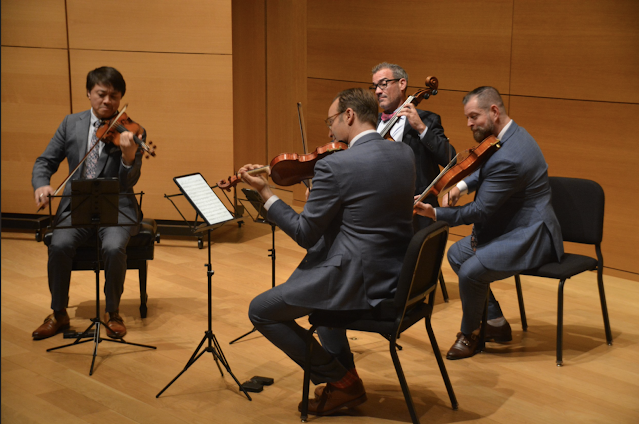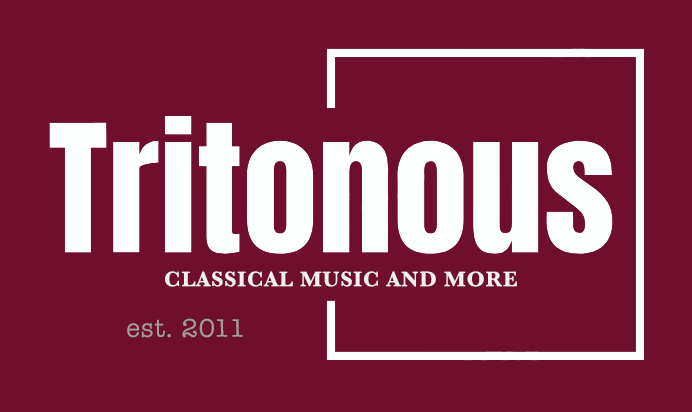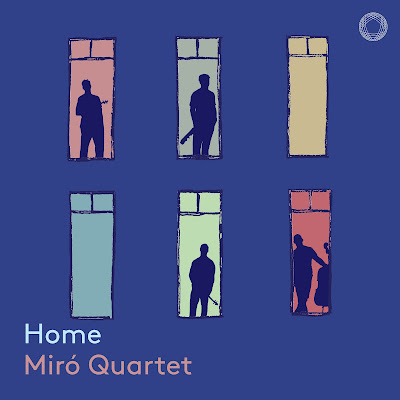![The Miró Quartet at La Jolla Music Society in 2024 [Photo: Ken Jacques] The Miró Quartet at La Jolla Music Society in 2024 [Photo: Ken Jacques]](https://tritonous.net/wp-content/uploads/2024/08/2024-02-20-La-Jolla2520Music2520Society2520-2520Ken2520Jacques.jpg) |
| The Miró Quartet at La Jolla Music Society in 2024 [Photo: Ken Jacques] |
The Miró Quartet‘s album, Home, released in May 2024 is the quartet’s second album on Pentatone, following their recording of Beethoven’s Complete String Quartets (2019). With the new album, the quartet explores the many concepts of what the term ‘home’ can mean. The pieces on the disc, all composed by Americans past and present, include two new commissions by Kevin Puts and Caroline Shaw, as well as known and lesser-known works by George Walker and Samuel Barber.
Based in Austin, Texas, the Miró Quartet is one of the USA’s most celebrated quartets. Founded in 1995, the current line-up is Daniel Ching and William Fedkenheuer, violin, John Largess, viola, and Joshua Gindele, cello. Daniel Ching and Joshua Gindele are founding members of the quartet, whilst John Largess has been a member since 1997. I recently chatted to John, via Zoom, about the new disc and the quartet’s approach to performing and commissioning music, how the composers they work with often become friends, and the challenges facing chamber music in the 21st century.
The quartet’s previous album featured Beethoven’s complete quartets whilst earlier albums focused on the music of Schubert, so this new album represents a significant change. Yet John emphasises that Home represents a big part of who they are as a quartet. They love new music, love commissioning music, and they also love 20th-century North American music. The classic repertoire remains important to them, and their Beethoven disc required a huge commitment from them in terms of concerts and studio time, so it felt natural to do a disc which showed another side to the quartet.
The new disc is partly named for Kevin Puts’ Home which appears on the disc alongside Caroline Shaw’s Microfictions [volume 1] but the idea of home extends both to the concept of musical home and artistic home. Puts and Shaw are not only commissioned composers but both are friends, part of the quartet’s community, another aspect of home.
Alongside these new pieces, the quartet plays String Quartet in B minor by Samuel Barber (1910-1981), which John calls a wonderful work they had long wanted to record, and the slow movement from Quartet No. 1 by George Walker (1922-2018)
The music of Beethoven and Schubert will always be at the core of the quartet’s repertoire, but this is music that is European and 200 years old. With the new disc, which is more personal than the earlier collections, the quartet brings out music that is contemporary and North American. John describes these pieces as wonderful, lyrical, romantic music. It was the music that came first and the idea of Home as a theme came later. They simply took the pieces that they were currently playing; both the Kevin Puts and Caroline Shaw works appeared during the COVID break and so naturally coalesced. The players are pleased with the result, the album was fun to make, and it was both challenging and fun to do the two premieres.
When John joined the quartet in 1997, its artistic vision was that they would love to premiere a new work each year alongside the more classical repertoire. At this period, John feels that there was a divide between quartets that did new music and those that did not. So there were groups like the Arditti Quartet and the Kronos Quartet who were ground-breaking in the way they performed only new and contemporary repertoire, groups that said we don’t need to play Beethoven and Shostakovich. This was important, these groups set a trend for performing contemporary repertoire, but what the Miró Quartet wanted to do was mix things up a bit.
That they achieved this artistic aim and more is a tribute to the ensemble’s vision and creativity. John estimates that they have done something like 45 to 50 new works since 1997. That figure includes 15 new works which the quartet recorded with Craig Hella Johnson and the choir, Conspirare on the album, House of Belonging, but even without those the total is impressive. All the great quartets of the past played music fresh off the composer’s pen, and continuing to do this keeps the players in the Miró Quartet engaged.
Whilst they do get asked not to play contemporary repertoire, John feels that promoters who ask this are in the minority, and others have explicitly requested that concert repertoire be drawn from the new disc. Recently they played a programme, at the Cooperstown Summer Music Festival, of the Walker, Shaw and Puts plus a Haydn quartet and the audience loved it. John finds that most audiences are interested in both classic repertoire and the more contemporary.
It is, however, important to provide a context for unfamiliar works, to talk about them and to bring them into the mix alongside more familiar pieces. And by combining the two, audiences often hear the traditional repertoire differently. From a purely business point of view, the quartet plays everything and they love the variety, switching programmes. John feels that sometimes, new music is presented as more difficult than it really is and that it is important to give people opportunities to hear it.
The music of Kevin Puts (born 1972) and Caroline Shaw (born 1982) resonates with the under 40s, their music often resounding with references Millennial audiences find familiar. Caroline Shaw’s Microfictions has a particular Millennial inspiration; Shaw drew her ideas from short micro-fictions created on Twitter during Lockdown . The result is a sequence of short movements, each with linking spoken poetry, that John feels is akin to scrolling through social media. Each movement is striking, vivid and short, each with its own caption, listeners are enthralled and then flip to the next. This idea of social media scrolling was not something that Shaw planned, she was simply inspired by the original material. However, the resulting work resonates with Millennial audiences. John adds that they love the way new music can invent new forms and find new audiences.
 |
| The Miró Quartet performing their Beethoven cycle at the Chamber Music Society of Fort Worth |
The quartet’s last European trip was in 2019, their recent concert experience has all been in the USA. There, a lot of the more venerable concert institutions have robust concert series but with an older audience, people who have been going for twenty years, and who are devoted, committed and older. Such concert series do not have so much pull for a younger audience. In smaller towns and at smaller venues, the audiences can be far more mixed, with young people and families alongside older people. When members of the quartet talk to former students who are still based in Austin, a lot of the groups have started their own concert series and started writing their own music, performing in traditional venues as well as other places, and these events are often packed out with audiences that are the performers’ age group alongside older people. John feels that there is an element of the current generation committing to artists of their own generation. He points out that if people are used to finding their Friday night evening’s entertainment via social media, then if they don’t see events like Chamber Music Society of Lincoln Center concerts there, they won’t go to them.
He also adds that in terms of economics, it is easier for younger artists to present a chamber music series than try to organise bigger (and more expensive) ensembles. And with a chamber ensemble, it is thus easier to bring contemporary repertoire into the mix.
Whilst the age of audiences is a concern, to a certain extent John feels that this is an oversimplification and there is enough activity for him to feel hopeful. But there is a lot to do. Whilst performers need to play contemporary repertoire, just as important is access to music itself. A lot of students want to study music but can’t (usually for social or economic reasons). Programmes inspired by those of El Sistema are focused on social change through music, but by making students creative they are around twenty times more likely to go out to a live concert. Music is important in people’s lives, and there is a need to focus on this more in the USA. There are strands of hope. An organisation like Sphinx encourages young musicians of colour, this has changed the landscape of who is performing, who is writing and who is listening to the music.
John thinks that the older generation of string quartet players sometimes felt that such outreach was beneath them and that it was sufficient to simply play the music. But now everyone wants to share what they are doing, going into schools, and posting on social media. Chamber music is a continuous living tradition and John finds it exciting to keep it alive, and he affirms that the live experience is always so powerful. People coming for the first time like live theatre and sport, there is no substitute for live. But with live music, there is an added layer, the sense of sharing music and emotions with the performers. For John, music is the best argument for its continued existence from Beethoven through to new pieces from contemporary composers who love the string quartet medium.
For the Miró Quartet, commissioned composers are often friends (like Kevin Puts and Caroline Shaw), though sometimes composers become friends thanks to the commissioning process. Bringing a new piece of music to life is a challenging experience, not unlike giving birth, it is dangerous and you don’t know what will happen. If the quartet is going to work on a new piece with a composer, to do workshops, then they often choose people that they know, people they feel comfortable with and can give feedback to. For instance, Caroline Shaw works very collaboratively. For Microfictions, they did Zoom calls with her, with the quartet playing parts of the music and Shaw demonstrating on her violin. To do this sort of work, you need a close relationship with the composer. Sometimes they have played pieces by composers that they didn’t know, but were recommended by friends, and after a week of workshops, you develop close friendships. John points out that the four members of the Miró Quartet have all been around long enough that there are few North American composers that they don’t know.
The quartet likes new works to feel like theirs, they dislike doing a work just once. They want to feel committed to a new piece so that they might play it where it might not be wanted or expected. Both the Kevin Puts and Caroline Shaw pieces on the disc have had over 50 performances each. This is a long way from doing a single OK performance of a work and never going near it again, but this means that they need to do more of a selection process before committing to a piece. For both the Kevin Puts and the Caroline Shaw pieces, the quartet put together a consortium of promoters who shared the premiere performances of the works, so that each piece got around six to eight performances during the first run. After all, if the quartet wants to pay the composers well, then they need to be performing the new work around 100 times during its first few years.
![The Miró Quartet (Daniel Ching, John Largess, Joshua Gindele, William Fedkenheuer) - [Photo: Jeff Wilson] The Miró Quartet (Daniel Ching, John Largess, Joshua Gindele, William Fedkenheuer) - [Photo: Jeff Wilson]](https://tritonous.net/wp-content/uploads/2024/08/3.2520MirC3B32520Quartet_C2A9Jeff2520Wilson.jpg) |
| The Miró Quartet (Daniel Ching, John Largess, Joshua Gindele, William Fedkenheuer) – [Photo: Jeff Wilson] |
Looking ahead, the quartet will be touring the repertoire from Home during the new season. In December they will be returning to the studio to record the complete quartets of Alberto Ginastera (1916-1983), a composer whose music the quartet loves, and John describes Ginastera as bringing a Latin vibe to 20th-century music, it is modern and modernist. The three quartets are contrasting works, the first is folksy the second is very 1960s atonal, whilst the third adds a soprano to the mix with lots of Spanish poets. They also have two albums of Haydn quartets coming up, and John says Haydn is a composer they love.
They will be working with saxophonist/composer Steven Banks on a programme that John describes as ‘totally off the wall’ including Osvaldo Golijov‘s 1994 piece The Dreams and Prayers of Isaac the Blind (originally for clarinet and strings) along with a new work by Bax for saxophone and quartet, plus music by Caroline Shaw and Hildegard of Bingen [see the Friends of Chamber Music’s website for details]
The quartet hopes to be in Europe again soon, having last visited in 2019. They used to play in Europe a lot and would like to be back.
Never miss out on future posts by following us
The blog is free, but I’d be delighted if you were to show your appreciation by buying me a coffee.
Elsewhere on this blog
- More Buffy the Vampire Slayer than German Romanticism: Gothic Opera’s Der Vampyr at the Grimeborn Festival – opera review
- Substantial and satisfying listening: Stuart Hancock’s score for the new film, Kensuke’s Kingdom – record review
- White-hot dramatic impetus: Meyerbeer’s Le prophète on LSO Live uses a traditional version but captures the work’s essential drama – record review
- Songs from two golden ages: Nicholas Mulroy, Elizabeth Kenny & Toby Carr in a recital of effortless beauty – record review
- Everything is connected: Barbican Quartet on their debut album, Manifesto on Love, on Genuin label – interview
- Vivacity, humour & pathos: Opera Holland Park & Charles Court Opera in Gilbert & Sullivan’s The Yeomen of the Guard – opera review
- Prom 24: Vividness & virtuosity in an astonishing danced staging of Purcell’s The Fairy Queen – opera review
- Prom 23: riveting symphonic theatre from Benjamin Grosvenor, Edward Gardner & LPO in Busoni’s Piano Concerto – concert review
- The encounter that never was: composers Alex Ho and Sun Keting on their collaboration on a new music theatre work interweaving the stories of two very different Chinese women – interview
- More than entertainment: Oliver Webber and the Monteverdi String Band’s The Madrigal Reimagined – record review
- Confidence, style and engagement: Rossini’s The Barber of Seville at West Green House Opera is a complete delight – opera review
- An eclectic mix: Brixton Chamber Orchestra at Clapham Park Cube – review
- Home









